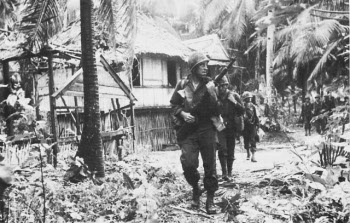![]() The Pacific War Online Encyclopedia
The Pacific War Online Encyclopedia
|
| Previous: Ranger, U.S. Fleet Carrier | Table of Contents | Next: Rangoon |

U.S. Army. Via ibiblio.org
The Rangers were U.S.
Army special forces
modeled on the British
Commandos. Their genesis came in April 1942, when Army chief of staff, George C. Marshall, and Louis Mountbatten,
commander of Combined Operations, discussed the possibility of having a
selected group of American officers and men train and operate with the
Commandos. Marshall's original intention was to then spread these men
among the units training for the Normandy invasion, to pass along their
experience. Eventually a plan evolved to organize a distinct American
commando unit.
The American in command of the new program, Lucian Truscott, was
encouraged by Eisenhower to keep new programs to a minimum and to chose
a distinctively American name for such units as were organized.
Truscott chose William Darby to command the first unit, and chose the
name "Rangers" from a long list of suggestions.
The Rangers were organized into battalions of about 500 men. Each Ranger battalion was composed of a headquarters company and six Ranger companies of six officers and 63 men. These were equipped as light infantry, with a heavy allotment of automatic weapons (four Browning automatic rifles and ten Thompson submachine guns to each company), but no heavy weapons heavier than bazookas and 81mm mortars. Six Ranger battalions were organized during the war, of which only the last saw service in the Pacific.
6 Ranger Battalion was assigned the task of clearing Japanese coastal artillery and radar positions from Dinagat, Homonhon, and Suluan, three small islands at the entrance to Leyte Gulf. Elements of the battalion landed on 17 October 1944, three days in advance of the main landings on Leyte. Dinagat was quickly cleared, but the Homonhan landing was delayed due to poor weather. The initial objectives on Suluan were also quickly achieved, but the Rangers continued to hunt down surviving Japanese here and on other nearby islands until 13 November. Thereafter the Rangers were employed on reconnaissance missions throughout the more rugged parts of the Philippines.
The most spectacular exploit of 6 Rangers was the raid on Cabanatuan on 30 January 1930, in which a force of 108 Rangers assisted by Filipino guerrillas and Alamo Scouts raided a prisoner of war camp holding survivors of Bataan and Corregidor. Some 512 prisoners were successfully rescued from deep behind Japanese lines in spite of interference by the Communist Hukbalahap. One Ranger, 26 guerrillas, and all 225 Japanese guards at the camp were killed.
References
The Pacific War Online Encyclopedia © 2008, 2011 by Kent G. Budge. Index